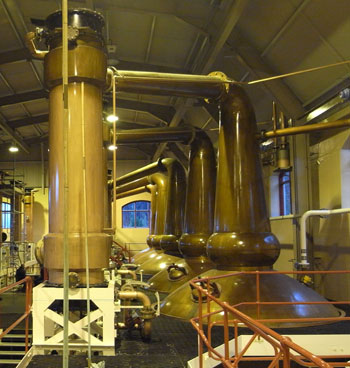You are on your first distillery visit with a group of bartenders and journalists:

The tour guide is talking about the ‘heart cut’ and everyone is nodding knowingly – you have no idea what he is going on about.
You are about to ask: “What the hell is a steam jacket?”* when a smug idiot says: “Can you tell me if the moss on the outside of the building affects the specific gravity of the wash?”
You hang your head in shame and pretend you know what is going on, like you did in French class at school.
Assumed knowledge
If you are a bartender, the industry will assume you know a lot about alcohol production and distilling. Arguably if you want to progress as a bartender, and do well in competitions, you should know a lot. But everyone has to start somewhere, so for those of you just starting your journey into spirits geekdom, here is a beginner’s guide to the creation of spirits.
A simple formula
All spirits go through two basic steps – Fermentation and Distillation.
Fermentation is the actual creation of alcohol; distillation is the process of removing it from the by-products of fermentation, and increasing its strength.
Fermentation

In order for fermentation to occur and alcohol to be created, a raw material containing sugar needs to be added in liquid form to yeast.
The type of raw material used will greatly affect the characteristics of the resulting alcohol, which is one of the reasons that dark rum (base material: molasses) and vodka (base material: grain) are so different.
A simple formula for the fermentation process would look like this:
Yeast + Sugar = Alcohol + C02 (Carbon Dioxide)
[stextbox id=”info”]On the subject of C02 – If you do visit a distillery and find yourself in the room housing the fermentation vats, don’t stick your head inside one, because people will shout at you… The amount of carbon dioxide in the vats could cause you to pass out and fall in![/stextbox]
Before fermentation can begin, the raw material has to be processed in a way that will allow it to be mixed with yeast in liquid form.
This involves some kind of milling and mashing, whereby the material is ground up to remove its husks or skins and release its starches.
This milled material is mixed with pure water and cooked to produce the mash. Yeast is then introduced to begin fermentation.
Alcohol is created as a result of the yeast consuming the sugars, producing congeners which give taste to the brew, and alcohol is slowly born.
Distillation

Once fermentation is complete, you have a vat filled with a mixture of water, mashed raw material, particles, waste products, and weak alcohol sometimes called the ‘wash’.
The next step in creating a spirit is to separate the weak alcohol from the wash, and increase its strength.
This is where the still comes in, and if you have never seen one, they don’t look anything like the moonshine makers in The Dukes of Hazzard.
The simplest form of still is the pot still, and these have been around since ancient Greece.
Essentially, a pot still consists of a bell-shaped vessel that holds the wash, and a thin neck that rises up, away and then down again.
A bit more maths
Distillation is all about temperature. Simply put, at sea level, water boils at 100 degrees Celcius, whereas alcohol boils at 78.
Therefore, if you heat the wash in the bottom of the still, the alcohol will boil before the water, and so it rises as vapour up into the neck of the still, separated from all the other elements of the wash.
Once it reaches the neck of the still, it cools and condenses back into liquid form, and gravity pulls it down until it finally drips out as clear, pure alcohol.
In Whisky production, this distillate is known as ‘low wines’.
Making the cut

Using Whisky production as an example, the first distillate, or low wines, are considered ‘a bit rough’. It may not be strong enough or smooth enough, and so it is distilled a second time to increase its strength and remove any remaining traces of waste.
[stextbox id=”info”]Column, or continuous, stills allow for a spirit to be distilled several times without leaving the system. They essentially behave like a series of pot stills in a vertical tube, and can maintain a continuous process of distillation, which is why they are often used by commercial distilleries.[/stextbox]
As this second distillation takes place, the first part of the batch to come out of the still is rejected, as is the last part.
However, somewhere in the middle of the batch is ‘the heart’, where the distillate is at its strongest and smoothest. The distiller will select the heart when he or she feels the time is right, and it is collected via the ‘spirits safe’.
This ‘heart cut’ is the now ready for blending, ageing, bottling, diluting or flavoring, depending on the product being made.
Next time
This article outlines the basic principles involved in creating a spirit, but as ever, God is in the details.
Different types of spirit have greatly differing production methods, which are dictated by desired taste, tradition, alcohol content and any number of factors.
In coming articles, we will be examining these sector-specific methods in detail with the help of the sort of experts who ask annoying questions about moss, so that you don’t have to.
*A steam jacket wraps around the base of a still to provide the heat needed to evaporate the alcohol.


